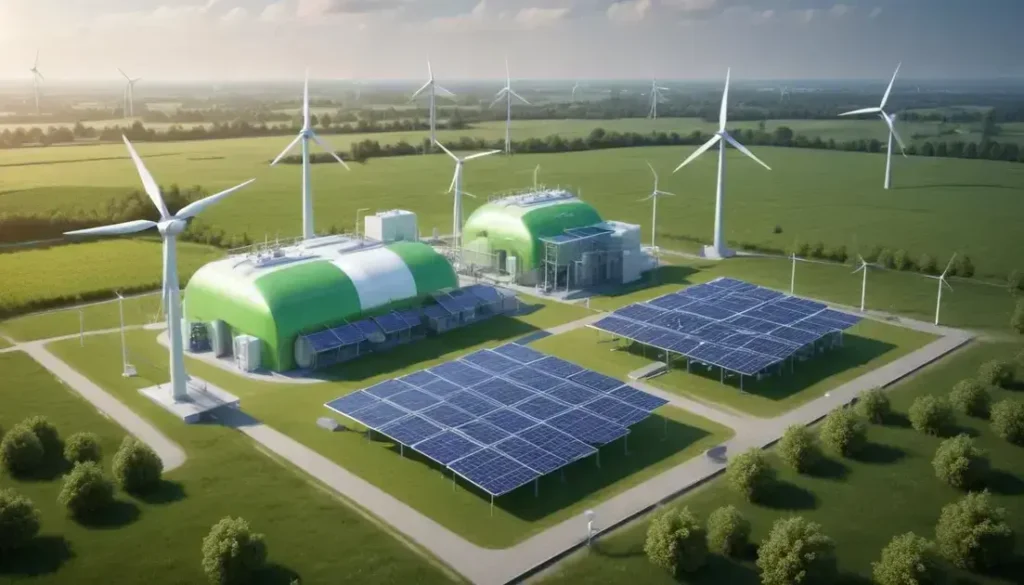Green bonds are financial instruments designed to fund environmentally beneficial projects, such as renewable energy initiatives, while providing investors with an opportunity to achieve returns and support sustainable practices.
Green bonds are making waves in California as the state plans to issue $1 billion to fund a 30-year supply of renewable energy.
Introduction to California Green Bonds
The introduction of green bonds by California marks a pivotal shift towards sustainable financing. These bonds are designed to raise funds for projects aimed at reducing environmental impacts, particularly within the renewable energy sector. By issuing $1 billion in green bonds, California aims to stimulate investments in clean energy and renewable infrastructure.
One significant aspect of these bonds is the ability to attract private and institutional investors who are increasingly concerned about environmental sustainability. The capital raised will support initiatives that promote energy efficiency, clean transportation, and carbon reduction. This comprehensive approach is expected to facilitate a transition towards a low-carbon economy.
Moreover, the success of California’s green bonds can serve as a model for other regions looking to enhance their environmental policies. As international focus intensifies on sustainability, other states and countries may adopt similar financial instruments to drive their green agendas. The implications for investors are vast, highlighting an opportunity not just for returns, but for contributing to a sustainable future.
Significance of Green Bonds in Clean Energy
The significance of green bonds in the clean energy sector cannot be overstated. These financial instruments are specifically designed to fund projects with positive environmental impacts, helping to combat climate change. By providing capital for renewable energy initiatives, green bonds are pivotal in transitioning towards sustainable energy.
One key advantage of green bonds is their ability to attract a diverse range of investors, including those looking to align their portfolios with sustainable practices. Institutional investors are increasingly seeking out these bonds as they offer a way to support environmentally beneficial projects while achieving financial returns.
Moreover, the issuance of green bonds often leads to enhanced public goodwill and brand reputation for companies involved in sustainable projects. This can positively influence their market position and consumer perception. As green bonds become more prevalent, they help establish a framework for measuring the environmental impacts of financing activities.
Additionally, government support and regulatory frameworks can further enhance the appeal of green bonds. With the backing of policies aimed at reducing carbon footprints, these bonds serve as a crucial link between finance and climate action, enabling businesses to invest confidently in clean energy projects.
Structure of the Green Bonds Initiative
The Structure of the Green Bonds Initiative is pivotal for understanding how financing is channelled into sustainable projects. Green bonds are structured as fixed-income instruments, similar to traditional bonds, but with the unique purpose of generating funds exclusively for environmental initiatives.
Investors purchase these bonds, providing capital upfront, while issuers commit to using the proceeds for specific green projects. This can include renewable energy systems, energy-efficient technologies, and sustainable agriculture practices. The framework ensures transparency in how funds are allocated and monitored.
Furthermore, green bonds are typically issued with varying tenors, ranging from a few years to several decades. This flexibility attracts different types of investors, including institutions seeking long-term stable returns and individuals interested in socially responsible investing.
The initiative often involves third-party verification, where independent entities assess the environmental impact of the funded projects. This step is crucial in building trust with investors, ensuring that the projects align with international green standards. By implementing such stringent measures, the Green Bonds Initiative not only promotes environmental sustainability but also enhances investor confidence in the potential positive impacts of their investments.
Benefits for the San Diego Community Power
The initiative for San Diego Community Power through green bonds presents numerous benefits for local residents. By investing in renewable energy projects, the community can achieve a significant reduction in its carbon footprint. This shift not only supports global climate goals but also fosters local job creation in the green energy sector.
Moreover, cost savings emerge as one of the key advantages. As the community transitions to cleaner energy sources, residents can expect lower energy bills in the long run. These savings are essential for families and can be reinvested into the local economy, further enhancing community resilience.
Green bonds also promote greater energy independence for San Diego. By harnessing local renewable resources, the region can decrease its reliance on fossil fuels and volatile energy markets. This shift not only enhances sustainability but also ensures more stable energy pricing for consumers.
Additionally, the transparency and accountability associated with green bonds instil confidence in the community. Residents will have access to information on how funds are allocated and the tangible impacts of their investments. This fosters a sense of ownership and engagement, allowing the community to actively participate in shaping its sustainable future.
Moody’s Rating and Financial Implications
The Moody’s rating of green bonds plays a crucial role in influencing investor confidence and market behaviour. This rating assesses the creditworthiness of the bonds, providing insights into the financial stability of the projects they fund. A high rating from Moody’s indicates that investors can expect reliable returns and lower risk, which is essential for attracting capital into sustainable finance.
Investors often look for ratings as a benchmark for their investment decisions. Higher ratings generally correlate with lower interest rates on the bonds, making them more attractive options for a broader range of investors. This can lead to increased liquidity in the green bond market, facilitating more funds for renewable energy projects.
Furthermore, the implications of Moody’s ratings extend beyond individual investments. A positive rating can elevate the reputation of the entire green bond market, encouraging more issuers to enter this space. It builds credibility for the environmental impact and financial viability of green projects.
On the contrary, a low rating can hinder market growth and discourage investment. This highlights the importance of maintaining high standards of transparency and accountability in the use of proceeds from green bonds. Ultimately, Moody’s ratings serve as a critical factor in the evolution of sustainable finance, shaping both investor expectations and the overall market landscape.
Market Expectations for Renewable Energy
The market expectations for renewable energy have shifted dramatically in recent years, as global awareness of climate change increases. There is a growing anticipation for substantial growth in renewable energy investments, driven by both governmental policies and private sector initiatives. Investors are increasingly recognising the potential for strong returns in clean energy markets.
Advancements in technology have made renewable energy sources, such as solar and wind, more efficient and cost-effective. As a result, these sources are becoming more attractive compared to traditional fossil fuels. The decreasing cost of renewable energy systems enhances their competitiveness, leading to greater adoption.
Furthermore, government incentives and subsidies for green technology are expected to bolster the renewable energy sector. Countries are setting ambitious emissions reduction targets, which further align with the global push for sustainability. This trend creates a favourable environment for renewable energy companies to thrive.
Market analysts predict that the transition to renewable energy will create millions of jobs globally, focusing on sectors like manufacturing, installation, and maintenance. As businesses pivot towards sustainable practices, the demand for renewable energy solutions is expected to surge, shaping the future of the energy landscape across the globe.
Opportunities for Australian Investors and Businesses
The rise of green bonds presents significant opportunities for Australian investors and businesses. As the world shifts towards sustainable finance, these instruments offer a pathway for local firms to contribute to environmental goals while capitalising on financial gains. By investing in green projects, Australian businesses can enhance their reputations as forward-thinking and responsible.
One key opportunity lies in the increasing demand for renewable energy and sustainable infrastructure. Investors can channel their funds into solar power, wind farms, and energy-efficient technologies, which are not only eco-friendly but also poised for growth. This creates a dual benefit of supporting the environment while generating returns.
Moreover, Australian companies that engage in green bonds can access a broader investor base, including those with specific mandates for socially responsible investments. This trend allows businesses to attract capital more easily, enhancing their financial stability.
Government incentives further bolster these opportunities, with policies supporting clean energy initiatives. These backing efforts create a conducive environment for investors to explore various sustainable projects. As Australia solidifies its position as a leader in the Asia-Pacific region for renewable energy, both investors and local businesses stand to gain from the continued growth in this sector.
Conclusion: Impact on Local and International Markets
The impact of green bonds on both local and international markets is profound and multifaceted. As these financial instruments gain traction, they not only drive investments in renewable energy but also enhance market stability by promoting sustainable business practices globally. The increasing visibility of green bonds encourages more companies to adopt environmentally friendly operations, leading to a ripple effect across industries.
On a local level, the influx of capital from green bonds can significantly boost economic growth. By funding community projects such as solar farms and energy-efficient buildings, these bonds create jobs and stimulate regional economies. This local investment in sustainability aligns with broader economic goals and positions local businesses as leaders in the green economy.
Internationally, the adoption of green bonds fosters a cohesive approach to climate action. Countries that prioritise green finance can attract global investors keen on sustainable portfolios. This helps create a collaborative framework for addressing climate change, as international markets increasingly look for ways to integrate environmental considerations into their investment strategies.
As the market for green bonds continues to expand, both local and international players will benefit from the positive socio-economic impacts. This trend not only supports a sustainable future but also enhances investor confidence and broadens access to capital for green initiatives.
In summary, the future of green bonds looks promising
Green bonds are shaping our approach to finance, encouraging investments in sustainable projects. These bonds not only support renewable energy but also create economic opportunities at both local and international levels.
As more businesses and investors recognise the benefits of green bonds, we can expect to see a significant shift towards a more sustainable economy. This trend will help combat climate change and promote social responsibility.
For individuals and companies looking to make a positive impact, engaging with green bonds offers a path to invest in a cleaner, greener future. The role of green finance is set to grow, enhancing the overall health of our planet and societies.
In conclusion, embracing green bonds is not just an investment in financial returns; it is also an investment in our future.
Frequently Asked Questions
What are green bonds and how do they work?
Green bonds are fixed-income instruments specifically designed to fund projects that have positive environmental impacts, such as renewable energy installations and energy efficiency improvements.
Who can invest in green bonds?
Anyone can invest in green bonds, including individual investors, institutional investors, and companies looking to enhance their portfolios with sustainable options.
What are the benefits of investing in green bonds?
Investing in green bonds can provide financial returns while supporting sustainable projects, contributing to environmental conservation, and enhancing an investor’s reputation.
How do green bonds impact local communities?
Green bonds can stimulate local economies by funding community projects, creating jobs, and promoting sustainable practices that improve overall quality of life.
Are green bonds a safe investment?
While green bonds carry some risks like any investment, those with high ratings from credit agencies can offer lower risk and stable returns. It’s important to assess individual bonds carefully.
What future trends are expected for green bonds?
The market for green bonds is expected to grow significantly as more investors prioritise sustainability, government policies support clean energy, and businesses seek to enhance their environmental impact.


